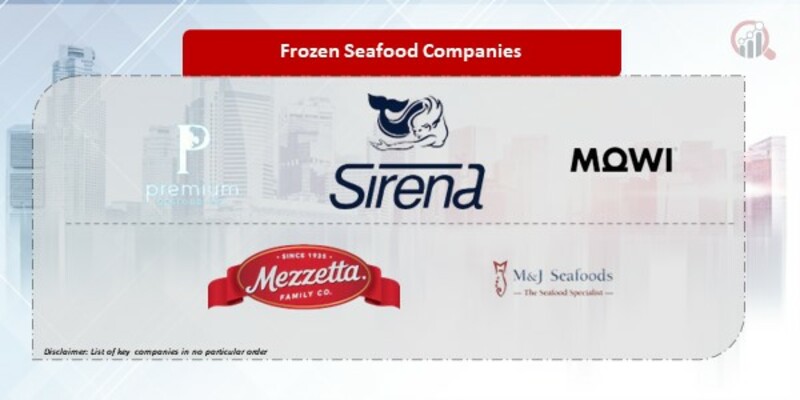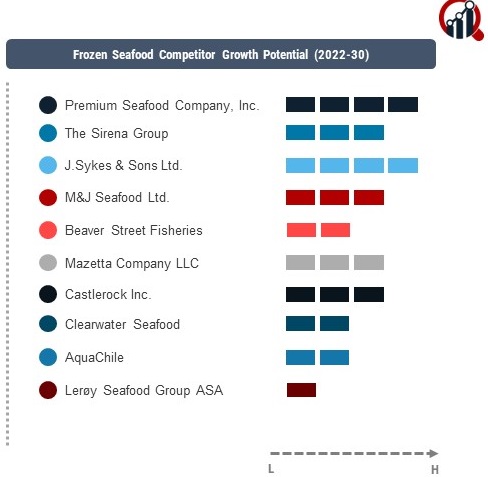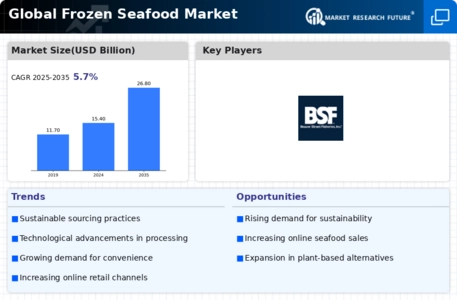Top Industry Leaders in the Frozen Sea Food Market

The Frozen Seafood Market is a dynamic sector shaped by global consumer preferences, sustainability considerations, and the efforts of key players to maintain a competitive edge. In this analysis, we delve into the competitive landscape of the Frozen Seafood Market, outlining key players, strategies adopted, market share determinants, emerging companies, industry news, current investment trends, and the overall competitive scenario in 2023.
Key Players:
- Premium Seafood Company Inc. (US)
- The Sirena Group (Denmark)
- M&J Seafood Ltd. (UK)
- Beaver Street Fisheries (US)
- Mazetta Company LLC (US)
- High Liner Foods Inc (Canada)
- Mowi ASA (Norway)
- Forster Frozen Foods Pvt Ltd. (India)
- IFC Frozen Seafoods (Canada)
- Castlerock Inc. (India)
Strategies Adopted:
Key players in the Frozen Seafood Market employ various strategies to navigate challenges, seize opportunities, and maintain a competitive position in the industry.
Vertical Integration: Some companies strategically opt for vertical integration, encompassing activities from fishing or aquaculture to processing and distribution. This approach enhances control over the supply chain, ensuring product quality and consistency.
Sustainability Initiatives: Recognizing the growing importance of sustainability, key players invest in sustainable fishing practices, aquaculture, and responsible sourcing. Certification programs, such as Marine Stewardship Council (MSC) and Aquaculture Stewardship Council (ASC), are often pursued to convey a commitment to sustainable practices.
Product Innovation: Continuous product innovation is vital for key players to cater to evolving consumer tastes and preferences. This involves introducing new value-added products, convenient packaging options, and adapting to emerging culinary trends.
Global Market Expansion: Given the global nature of the Frozen Seafood Market, key players focus on expanding their market presence internationally. This often involves strategic partnerships, acquisitions, and establishing distribution networks in key regions.
Market Share Analysis:
Market share dynamics in the Frozen Seafood Market are influenced by various factors that reflect consumer preferences, industry standards, and the ability of companies to adapt to changing market conditions.
Product Quality and Safety: Companies that prioritize and consistently deliver high-quality and safe frozen seafood products tend to secure a larger market share. Adherence to strict quality control measures and certifications contributes to consumer trust.
Sustainability Practices: With an increasing awareness of environmental concerns, companies engaging in sustainable and responsible seafood practices gain favor among consumers. Market share is influenced by the perceived commitment to environmental responsibility.
Brand Reputation: Established brand reputation plays a crucial role in determining market share. Companies with a positive brand image, built on factors such as transparency, reliability, and ethical business practices, attract and retain a larger consumer base.
Distribution Network: The efficiency of a company's distribution network impacts its market share. Key players with widespread and well-managed distribution networks can quickly respond to market demands and ensure product availability.
News & Emerging Companies:
News within the Frozen Seafood Market often revolves around sustainability initiatives, new product launches, and global expansion efforts. Emerging companies focus on niche markets, innovative product offerings, and differentiation strategies to carve a space for themselves in the competitive landscape.
Industry news also reflects collaborations between seafood producers, retailers, and conservation organizations to address environmental concerns and promote sustainable practices.
Industry Trends:
Investment trends in the Frozen Seafood Market mirror the industry's commitment to sustainability, technological advancement, and meeting the evolving demands of consumers.
Sustainable Packaging: Companies invest in research and development to adopt sustainable packaging solutions, minimizing the environmental impact of packaging materials. This aligns with broader industry efforts to reduce plastic waste and embrace eco-friendly alternatives.
Technology Integration: Key players integrate technology into various aspects of their operations, from supply chain management to processing facilities. This includes the use of data analytics, IoT (Internet of Things), and blockchain technology to enhance traceability and transparency.
Aquaculture Innovation: Investments in aquaculture innovation, including the development of advanced farming techniques and technologies, signify a commitment to sustainable seafood sourcing. Companies explore ways to improve efficiency and reduce the environmental footprint of aquaculture practices.
Competitive Scenario:
The Frozen Seafood Market is characterized by intense competition, where key players vie for market share through a combination of sustainable practices, product innovation, and global market presence. The industry's adaptability to changing consumer preferences and its commitment to environmental responsibility contribute to a competitive yet dynamic landscape.
Recent Development
The Frozen Seafood Market was the industry's collective efforts to address traceability and transparency challenges. Key players collaborated to implement blockchain technology in the supply chain, enabling consumers to trace the journey of seafood products from source to shelf. This development reflects the industry's commitment to ensuring the integrity of the supply chain and meeting the growing demand for transparency among consumers.










